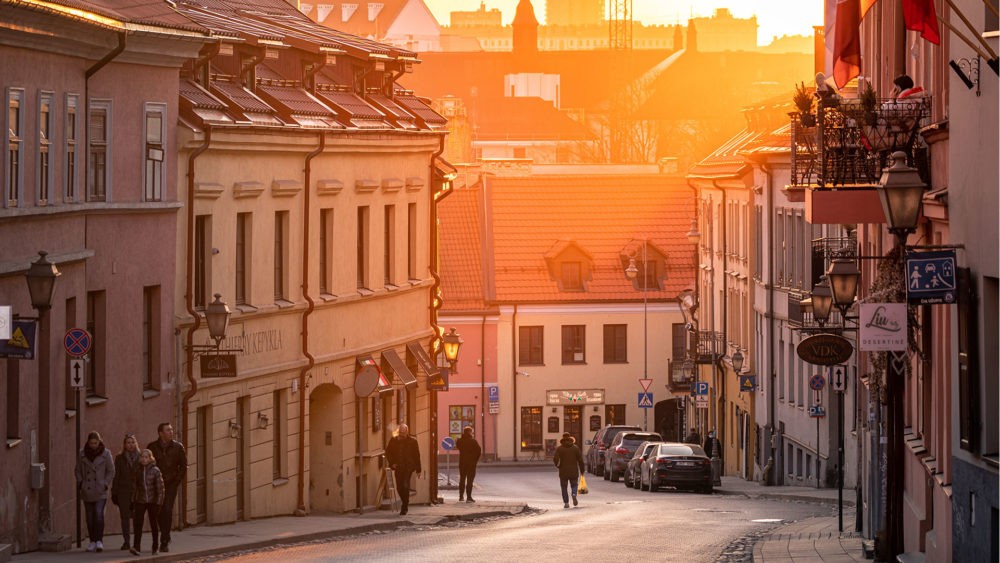Swap landmarks for local markets
Whenever I embark on a trip, I’m always on the hunt for vibrant, authentic local life. Souvenir kiosks don’t interest me. I will always skip the duty-free shops and tourist zones, where people are more likely to approach you in English than their native language. What do I search for instead? Market squares with vendors selling antiques, local artisans transforming ancient techniques to create moderncrafts, galleries where artists are pushing the boundaries of what creativity means. Where do I go to find these places? Europe, but perhaps not the Europe that appears in the guidebooks.
I’ve long preferred to explore the smaller cities, the ones that don’t always pop into mind when you tell your friends or family that you’re taking a trip to Europe. Though I love the beauty and refinement of Europe’s old capitals, as a young, artistically minded person, I’m far more drawn to cities like Vilnius, in Lithuania, where I have come across some of the most remarkable artists and artisans anywhere in the world—and let me tell you, I’ve traveled a lot. If you’re not familiar with this Baltic city, I would best describe it as a capital with a village vibe and an intrinsic dreamy quality. If you were to see it from a bird’s-eye view, you’d look down at lush trees, terracotta roofs, and church spires shooting up toward the sky. But my favorite view of the city is the street level, where any visitor will find him or herself among artisan shops, galleries, and street art stretching across buildings.
The best place to find young craftsmen and women using techniques that stretch back as far as the Vikings for new exciting applications is the neighborhood of Užupis, an artist colony that has declared itself an independent micro-nation. It even has its own constitution, which you can read here. My favorite amendment is this one: Everyone has the right to love. When you’re exploring this creative quarter of Vilnius, make sure to stop at the Užupis Art Incubator, where you can buy local art from some of the city’s most promising creatives. Another great place to stop is the Tibet Square, where you’ll find a tiny lending library. Find a book that piques your interest and relax in the sunlight as I once did!

Browse architecture studios and concept stores in the sunny city of Zagreb
I fancy myself a bit of an explorer when it comes to creative cities. Often, a new exciting place crops up in very little time, in places where you might not expect it. This was the case when I discovered several streets on the eastern end of Zagreb, Croatia. In a neighborhood once home to hardware stores, body shops, and car dealerships, most of which closed over twenty years ago not long after the fall of the Soviet Bloc, young designers, architects, painters, and entrepreneurs have now moved in, taking advantage of the cheap rents and creative vibe. Here are some of the places I discovered and loved: the literary club, Booksa, which has been a wonderful cultural space for avid readers and literary figures for almost twenty years. Visit Booksa for, of course, the books. But stick around for its engaging events and warm community. From there, explore the many concept stores, including several that put a distinctly Croatian spin on Scandinavian design–thinking. Consider Martićeva or Vlaška Street as places to start off from. In my opinion, exploring a city conjures a great thirst and hunger. Luckily, this part of Zagreb has much to offer in terms of interesting, modern cuisine—and great coffee! Otherwise, take a short trip to the Dolac Market, right in the center of town. Under its famed red umbrellas, you will find—just as I did—some of the freshest produce you’ve ever tasted. This is also a great place to interact with locals, who do their shopping here as they have done for decades.

In Belgrade’s Dorćol, discover a burgeoning scene of music, art, and literature
I’ve always had a love for converted spaces—i.e. old factories or warehouses, which, instead of being torn down, are transformed into artist colonies, galleries, cafes, bookshops, or community centers. In the quarter of Dorćol, in Serbia’s capital, Belgrade, I found a neighborhood brimming with life in…you guessed it…numerous converted spaces. When you stroll through Dorćol, you find funky cafes (some with wonderful inner gardens and courtyards), galleries featuring the city’s young, new artists, and places where you can find vintage vinyl records, artisan bread, and indie bookshops. Are you a bicycle lover like me? Another great way to explore Dorćol is on wheels—there are even bike lanes in many parts of the quarter! Above all, what awed me most about Dorćol was the welcoming vibe of the people—do as I did and chat with bartenders, baristas, and shop workers. They know the best hidden secrets of the city.
When I reflect on my time exploring creative European cities, one emotion sticks out: Europe is alive, its cities are filled with movement and change and energy. To have an exciting urban adventure on this continent is as simple as seeking out cities like these three I covered in this article. Here are some tips that really worked for me as I planned my trip: while big capitals are great, think about some of Europe’s smaller cities, where creatives flock to cheaper rents and more artistic freedom. Then, make sure to plan ahead—read articles like this one (yes, a shameless plug) to know which specific neighborhoods in various cities are attractive to you. Last, go with the flow. Walk around, pop into random shops, strike up conversations. This kind of spontaneity always opens doors. Oh, and one final thing—join the Visit Europe Facebook group for creative city travelers– Creative City Lovers Europe! Share your experiences, learn from those of others, belong to a community.